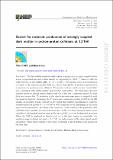Search for resonant production of strongly coupled dark matter in proton-proton collisions at 13 TeV
Author(s)
Tumasyan, A.; Adam, W.; Andrejkovic, J. W.; Bergauer, T.; Chatterjee, S.; Damanakis, K.; Dragicevic, M.; Escalante Del Valle, A.; Frühwirth, R.; Jeitler, M.; Krammer, N.; Lechner, L.; Liko, D.; Mikulec, I.; Paulitsch, P.; Pitters, F. M.; Schieck, J.; ... Show more Show less
Download13130_2022_Article_18636.pdf (3.074Mb)
Publisher with Creative Commons License
Publisher with Creative Commons License
Creative Commons Attribution
Terms of use
Metadata
Show full item recordAbstract
Abstract
The first collider search for dark matter arising from a strongly coupled hidden sector is presented and uses a data sample corresponding to 138 fb−1, collected with the CMS detector at the CERN LHC, at
s
$$ \sqrt{s} $$
= 13 TeV. The hidden sector is hypothesized to couple to the standard model (SM) via a heavy leptophobic Z′ mediator produced as a resonance in proton-proton collisions. The mediator decay results in two “semivisible” jets, containing both visible matter and invisible dark matter. The final state therefore includes moderate missing energy aligned with one of the jets, a signature ignored by most dark matter searches. No structure in the dijet transverse mass spectra compatible with the signal is observed. Assuming the Z′ boson has a universal coupling of 0.25 to the SM quarks, an inclusive search, relevant to any model that exhibits this kinematic behavior, excludes mediator masses of 1.5–4.0 TeV at 95% confidence level, depending on the other signal model parameters. To enhance the sensitivity of the search for this particular class of hidden sector models, a boosted decision tree (BDT) is trained using jet substructure variables to distinguish between semivisible jets and SM jets from background processes. When the BDT is employed to identify each jet in the dijet system as semivisible, the mediator mass exclusion increases to 5.1 TeV, for wider ranges of the other signal model parameters. These limits exclude a wide range of strongly coupled hidden sector models for the first time.
Date issued
2022-06-29Department
Massachusetts Institute of Technology. Department of PhysicsPublisher
Springer Berlin Heidelberg
Citation
Journal of High Energy Physics. 2022 Jun 29;2022(6):156
Version: Final published version